Survival in the saddle • part 3
Like all of the features on the Roadcraft USA blog, this post about riding in the rain will reach riders of all different experience levels. The seasoned veterans among you may already know a good deal of the information that is outlined herein. To you, I hope it serves as a quick refresher course. It’s never a bad thing to review the basics every once in a while.
For the less experienced riders I hope this post serves as the inspiration you need to safely and intelligently take on greater challenges. You will certainly have more rewarding experiences in your two-wheeled travels as a result.
We All Started Somewhere
In nearly four decades of riding I have never met a biker that said their first experience on two wheels took place during a heavy rain storm. Most of us learned to ride in nice dry conditions. Many had their first experiences on dirt bikes in an off road environment.
Until you’ve done it…done it well…and done it a lot; you will not have the confidence that dry pavement inspires. In other words it is no wonder that riding in the rain is a concept that instills fear in the uninitiated. It’s simply an unknown that just needs to be addressed and conquered.
Not A Joy Ride
Let’s face it. Riding in inclement weather is not the same wonderful experience as carving up your favorite roads on a picture-perfect summer day. There are some of you that are fair weather riders. Those who ride only in ideal conditions. Those who don’t venture far from home. That’s fine with me. No judgement.
But once you decide to adopt long distance motorcycle travel as a lifestyle you’ve made a determination. It won’t always be a bed of roses. Into each life some rain must fall. You can be one of the folks that spends all day hunkered down in a motel room or hiding under a highway overpass. Or you can develop the skills and mindset needed to become an all-around accomplished two-wheeled adventurer.
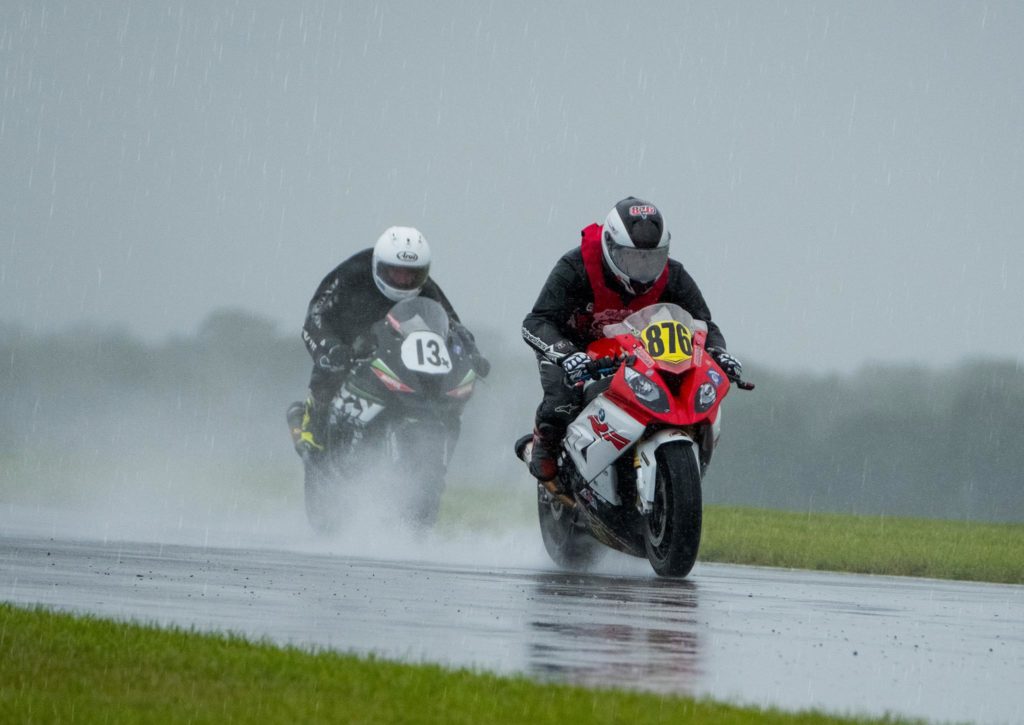
150 MPH in the rain! On the backstretch of The Thunderbolt Course at New Jersey Motorsports Park
Technology Rocks
For this section I’m going to borrow a couple of paragraphs from my Amazon best-seller road travel book Road Work: Images and Insights of a Modern Day Explorer
“Unlike some of the primitive machines I’ve ridden in the past, today’s two-wheeled vehicles are technological wonders. Starting from the ground up the modern motorcycle rolls on advanced tire designs…multi-compound creations that provide enhanced longevity, increased traction on varying road surfaces and highly efficient water dispersion characteristics making travel in rainy conditions a relatively safe proposition.
The best motorcycles today come equipped with advanced electronic monitoring and control systems. Programmable riding modes for various scenarios. On-the-fly electronic suspension adjustment. Traction control systems. Automatic stability control. Common automotive features like proportional ABS braking and electronic fuel injection have been a part of modern motorcycle design for decades”.
Tire Types And Traction
The type of bike you ride, the kind of riding you do, and the tires you choose to do it with are of prime consideration when talking about riding in the rain. As with most things in life, every choice has its advantages and compromises.
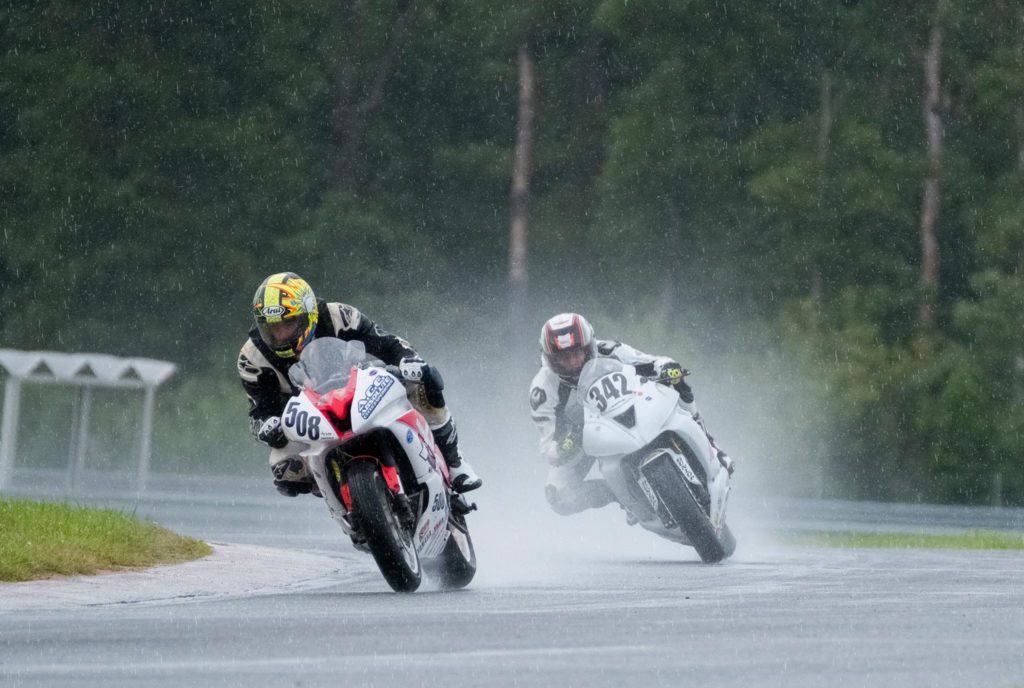
When the rain starts falling the proper tires are mounted
I run Metzeler Roadtec 01 tires on my mid-sized sport touring bike. Beyond any doubt whatsoever, these are the best wet weather tires I’ve ridden on in nearly four decades of motorcycling. That doesn’t mean they’re the best for everyone.
Different Tires For Different Bikes and Conditions
Tires for sport bikes, especially those that do double duty on track days, are rarely fitted with tires that perform well in the wet stuff. The wide, soft compound designs have limited lateral grooves. It is for this reason that racing bikes are fitted with different tires depending upon the conditions likely to be encountered on race day. If you choose to travel far on a sport bike make a sensible tire choice. You’ll have to forfeit a little bit of dry pavement speed, but you’ll survive rainy encounters with Mother Nature.
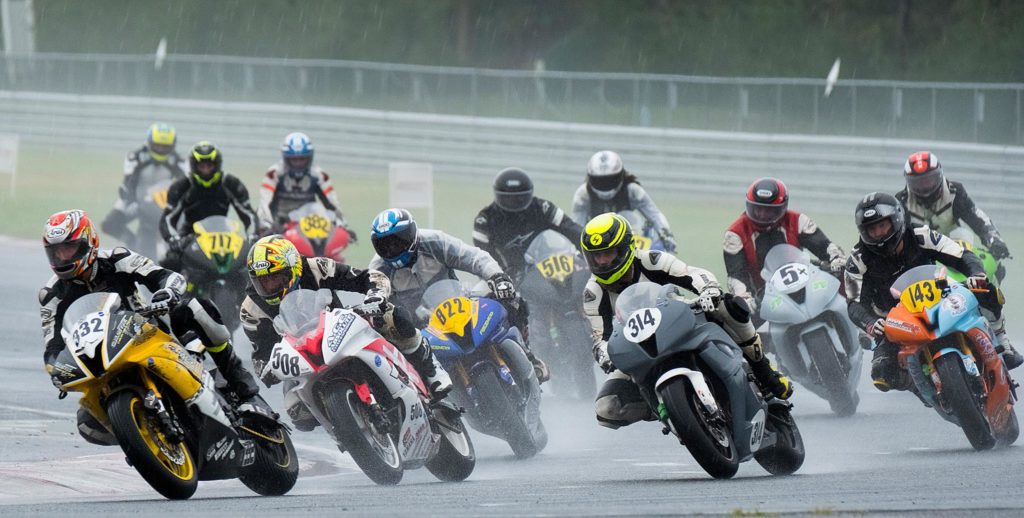
In the rain…into a curve…in a pack. Confidence in yourself, your machine and your competition is imperative
Adventure bikes (ADV) are most often fitted with “knobby” tires designed to take on the rigors of off-road riding. Their tread patterns are designed to grab on loose gravel, dirt, mud and other horrible surfaces. By design these tires do not perform well on the road in the rain. There are some ‘hybrid’ on road/off road designs offered. The most accomplished ADV rider I’ve ever known stated that none of them are very good. He would change the tires completely on his BMW GS Adventure bike when he ventured away from the highways and into the wilderness.
The 80% Rule
The first confidence-building concept to grasp is what I refer to as the 80% rule. Simply stated, I propose that bare, wet pavement offers approximately 80% of the traction afforded by dry pavement. Therefore, very simple conclusions can be drawn.
If your speed is moderated to just 80% of what you would be comfortable with under dry conditions, your ability to bring the motorcycle to a stop is exactly the same on bare wet pavement. If the angle you are capable of leaning your bike is kept to just 80% of what you can realistically maintain on dry pavement, you’re not going to slide out on the bare wet pavement.
In other words all you need to do is slow down a bit and not lean into the curves so aggressively. All will be fine. When you think of it this way the mystery (and mastery) of riding in the rain starts to come into perspective.
Rules Are Meant To Be Broken
The problem with the 80% rule is that it uses the words bare, wet pavement. It’s easy to find wet pavement but rare, indeed, to encounter bare surfaces. To understand what happens to roads when they get wet you must first consider what happens to them all of the time.
Vehicles that traverse the highways and byways leave behind contaminants of all types. Oil, antifreeze, tire rubber, grease and other lubricants are constantly being dispersed onto the road surface. It gets ‘applied’ in truly minuscule amounts, but adds up after thousands of vehicle miles. This is why the center part of traffic lanes appear darker than the outer wheel tracks.
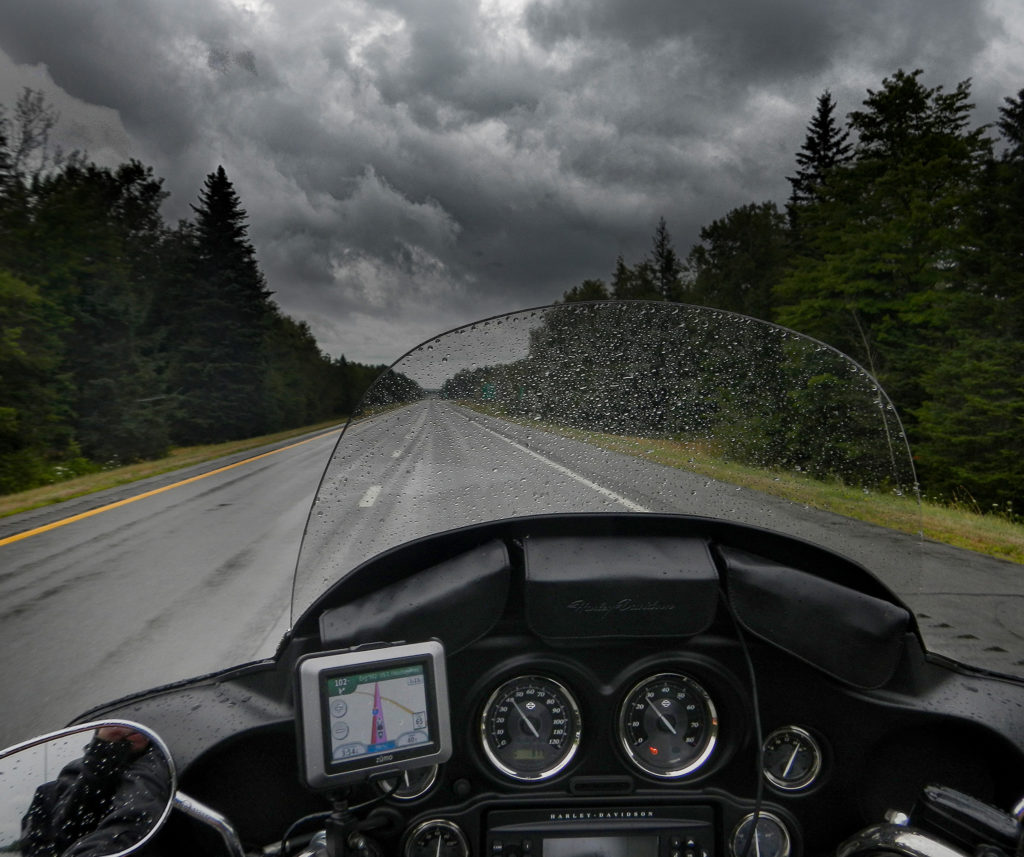
Only 102 more miles of this according to the GPS
Take A Short Break
The good news is that most of this slick, dangerous residue gets washed away into the road’s gutters during a rain event. The bad news is that until it does, the pavement is going to be extraordinarily slippery. There are two conclusions to draw from this lesson.
First: the most dangerous (slippery) conditions will be encountered when the pavement is first being exposed to the rain. Similarly a slight amount of mist or morning dew can render the pavement just as slippery as the start of a rain event. In addition, the least traction will be available in the center of the traffic lane. This is true in rainy or dry conditions, but is especially evident in the wet stuff.
Lessons To Learn • Strategies To Employ
When you decide to get underway again, keep your bike in the outer wheel tracks of the traffic lane. Stay away from that darker center strip as much as possible. That’s where the greatest accumulation of slippery contaminants would be found. When rounding cambered curves use the uphill wheel track to further decrease your lean angle.
The basic strategies to apply here are simple. For your first experiences riding in the rain I urge you to sit out the first few minutes of a storm. Give Mother Nature time to wash all of that slick stuff off the roads and into the storm drains.
You’re off and running now. Remember the 80% rule. Keep your speed down to no more than 80% of what you would be comfortable with on dry pavement. The slower speeds will naturally result in reduced lean angles in the curves. Leave at least 20% more room between you and the vehicle in front of you. You’re on your way to becoming a real rain warrior.
Smooth Operator
The next technique to master when riding in the rain is to make all inputs as smooth as possible. Roll on the throttle smoothly and gently as you accelerate. Make your gearshifts earlier than you would than if you were accelerating briskly. Avoid the kind of high RPM shifts that might break tire traction with the road surface.
Apply your brakes as smoothly as possible when decelerating and stopping. Squeeze the front brake lever gently and continuously. Apply steady, even pressure to the rear brake. The goal here is to effect smooth stops without locking up either the front or rear wheel.
Use your engine’s natural decompression to slow the bike by rolling off the throttle smoothly. This would be a good time for the big twin riders with loud pipes to forego the ritual of pulling in the clutch and revving the throttle. Keep the clutch engaged and take advantage of engine braking for smooth, safe stops.
Rain Specific Road Hazards
I’ve often stated that things that are a mere inconvenience to automobiles can be deadly to motorcyclists. This grim fact becomes even more pronounced in wet weather. The list of hazards you will encounter is endless, but here are some specific threats you should be watching for.
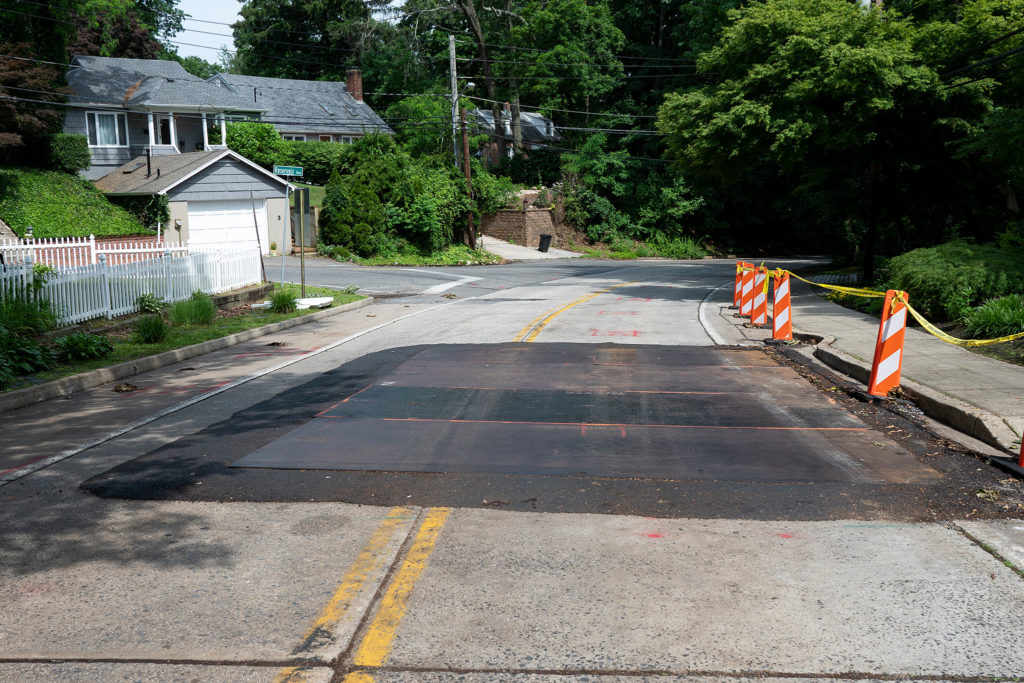
These steel plates are as slippery as ice when wet!
Steel plates in construction zones. These are as slippery as ice when wet. Slow down before you cross them and keep as much weight as possible on your pegs. Stay as perpendicular as possible to the road surface. Be prepared for a momentary loss of traction when your wheels hit the obstruction.
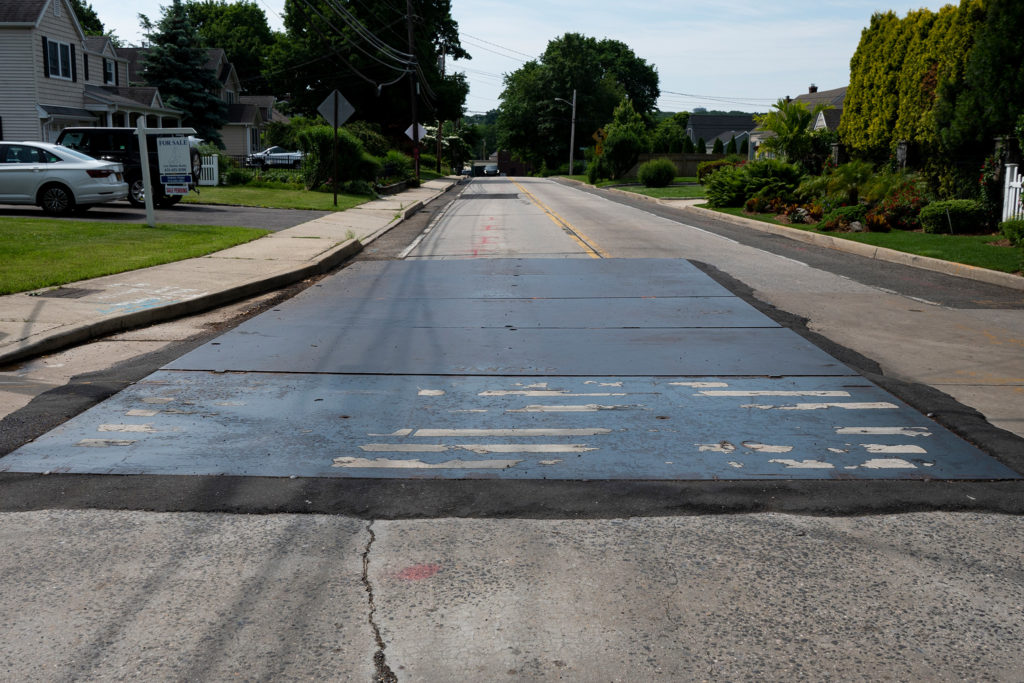
Be prepared for a momentary loss of traction when you hit one of these plates
Everyday Encounters
Railroad tracks. The steel or composite surfaces on either side of the rails are just as slippery as those construction zone steel plates. Slow down and hit them as near to a 90 degree angle as possible.
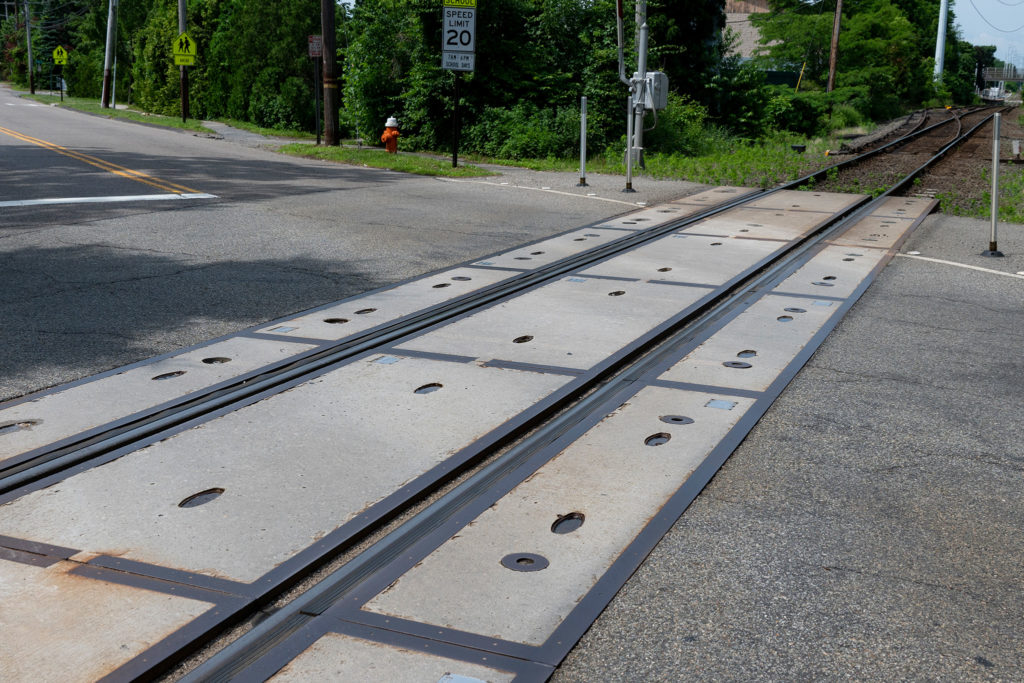
Paint. The painted lines, arrows and such on the road surface have much less traction than the pavement itself. Avoid riding over them if possible. Use extreme caution if you’re forced to come to a stop or put your feet down on them.

The usual suspects. Leaves, grass clippings, animal waste, ‘tar snakes’. In other words, all of those other hazards we encounter become even more of a nuisance when wet. Stay alert.
Change Your Route If Warranted
At this stage of my life I prefer riding on the roads less traveled. Scenic backroads. Technically challenging, twisty, rural routes are my preference. But when a large storm is in my path I will often resort to ‘slabbing it’ on a major highway.
I have two reasons when making this less-than-desirable decision. Often I just want to put the wet weather behind me. A 65MPH Interstate burn will do that much faster than a leisurely backroads route. In addition, the major roads are often much more predictable when it comes to things like better storm drainage, and increased maneuverability. In addition the threat of other vehicles unexpectedly entering into your path of travel is reduced.
The downside is that you’ll be faced with other vehicles approaching you from behind with decreased visibility. You’ll be subjected to water and wind drafts generated by high profile vehicles like buses and semis. Make your choice based upon the individual circumstances you’re facing.
There’s An App For That
Decades of motorcycling, alongside quite a few years of deep sea fishing, have made me something of a weather geek. We have great tools available today that were simply unavailable in the past. Weather apps are one of them.
I don’t recommend using a smartphone on your motorcycle. My reasons are laid out in a previous post that addresses that subject. I do, of course, have one on my person and it is invaluable as a weather forecasting device. Get yourself some reliable weather apps and learn to use them to your advantage.
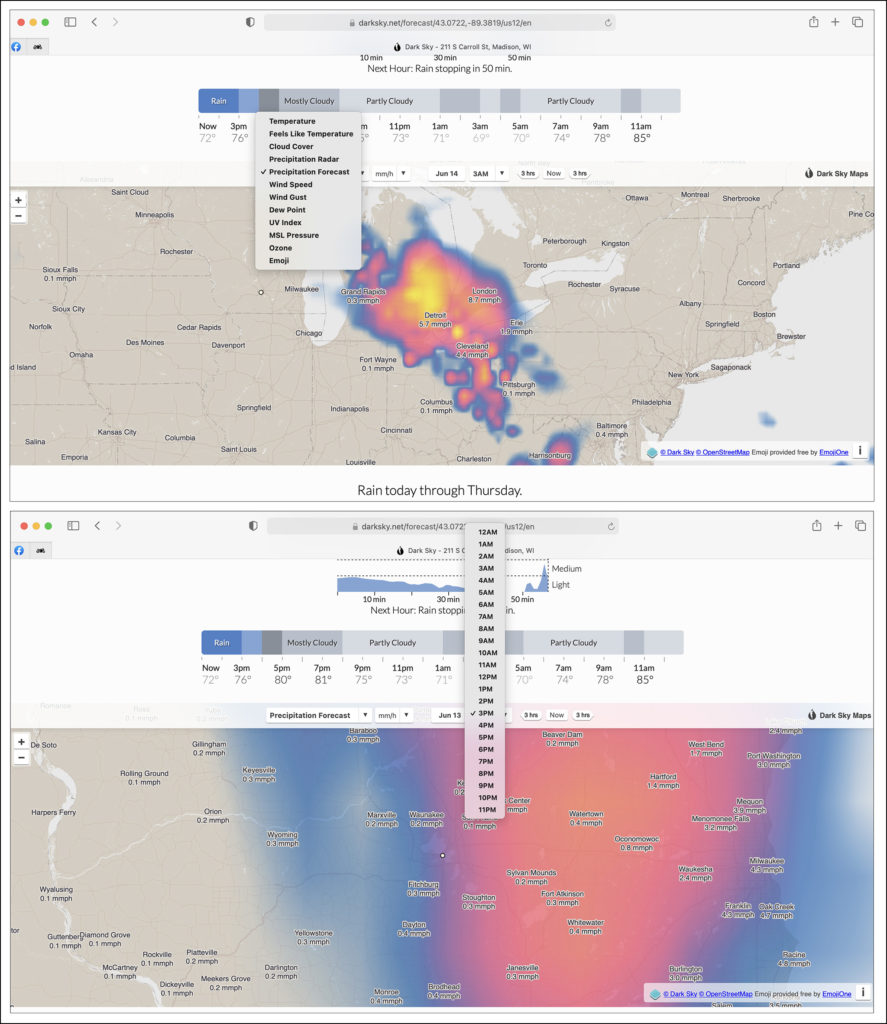
The Dark Sky desktop resource provides hourly forecasts for numerous weather elements
My favorite forecasting app is “Dark Sky”. I use this resource on my smartphone and on my computers. The desktop interface is much more elegant to use (and free!). The smartphone version provides all of the same information…albeit somewhat clumsily. I have found it to be the most accurate weather app out there. (In a world where weather forecasting sadly seems to be less than an exact science).
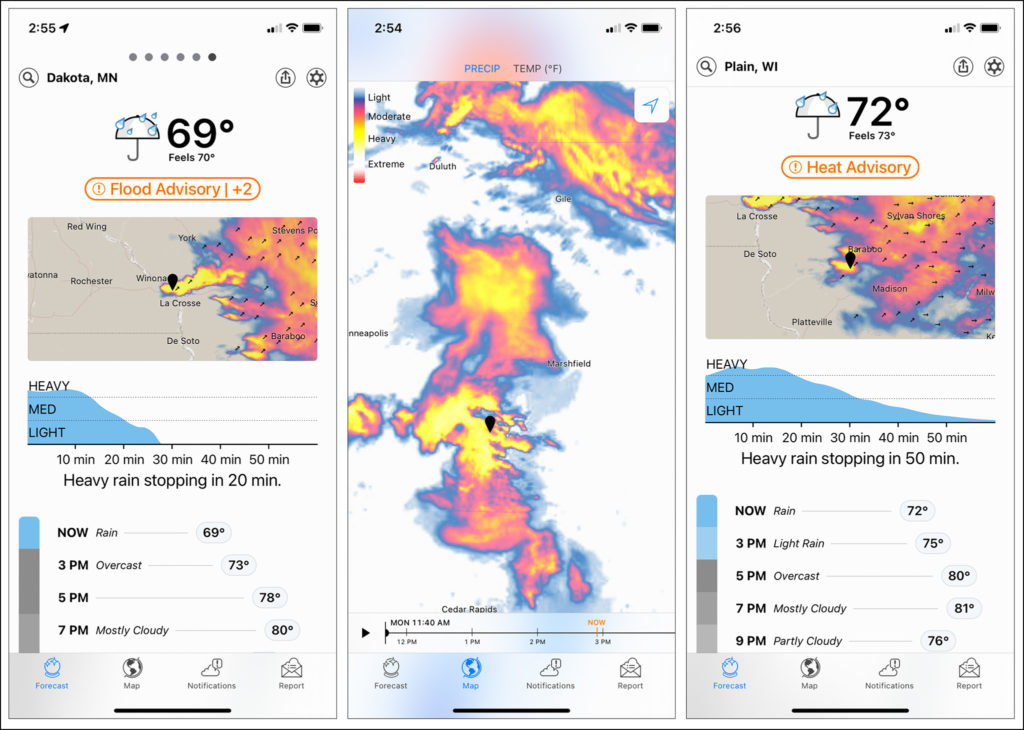
Most of the same information can be accessed on the Dark Sky mobile app
Live Weather Radar App
My favorite live weather radar app is “Radar Scope”. All of the good ones are tied into the same weather radar stations located around the continent. Choose the one you’re comfortable with. Both of these apps carry a one-time cost of a few bucks. They have proven to be worth every penny. Knowing where the storms are and how severe they are is important. Knowing what direction they’re moving and how fast they are traveling? That’s all you need to know to make solid weather-related decisions.
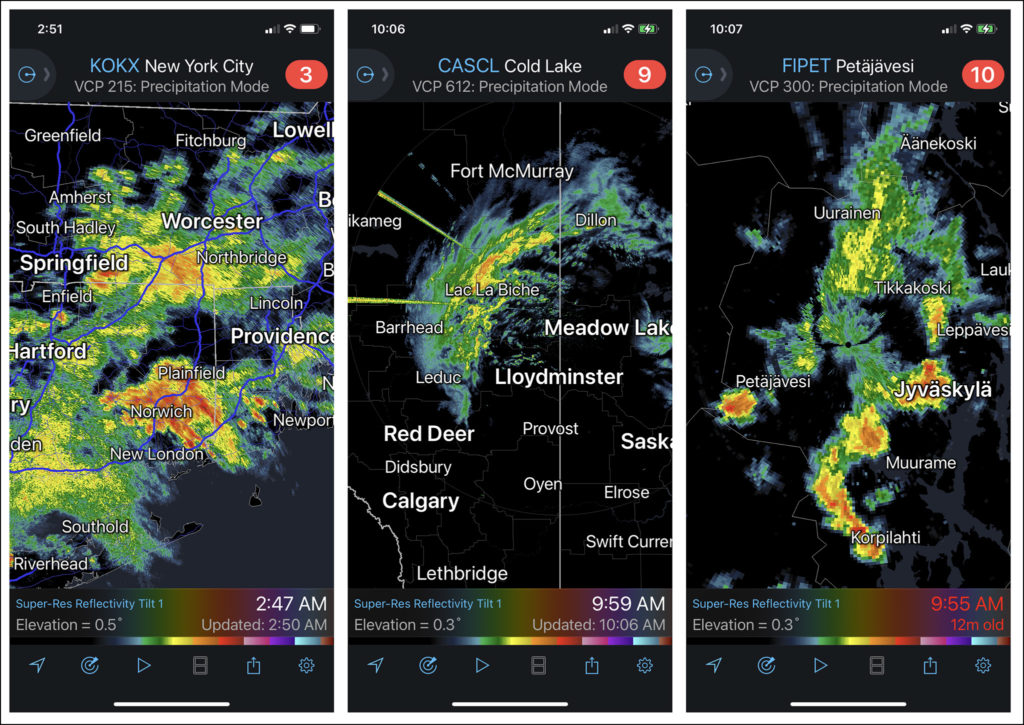
The Radar Scope app provides weather radar images in the US, Canada and Europe
Dress For The Occasion
In a previous post I discussed riding apparel. This is a subject that becomes even more important when talking about riding in the rain. The difference between a successful foul weather outing and a complete horror story is often the clothes you’re wearing.
Staying dry is nice. Staying warm is critical. Riding around in soggy leather, denim or textile apparel is more than a miserable feeling. It can be dangerous. At even moderate temperatures and speeds you can become chilled to the core. Hypothermia can set in. Muscle control will suffer along with reduced mental acuity. Riding in bad weather is not the time you want your mental and physical faculties to become diminished. Be smart. Gear up.
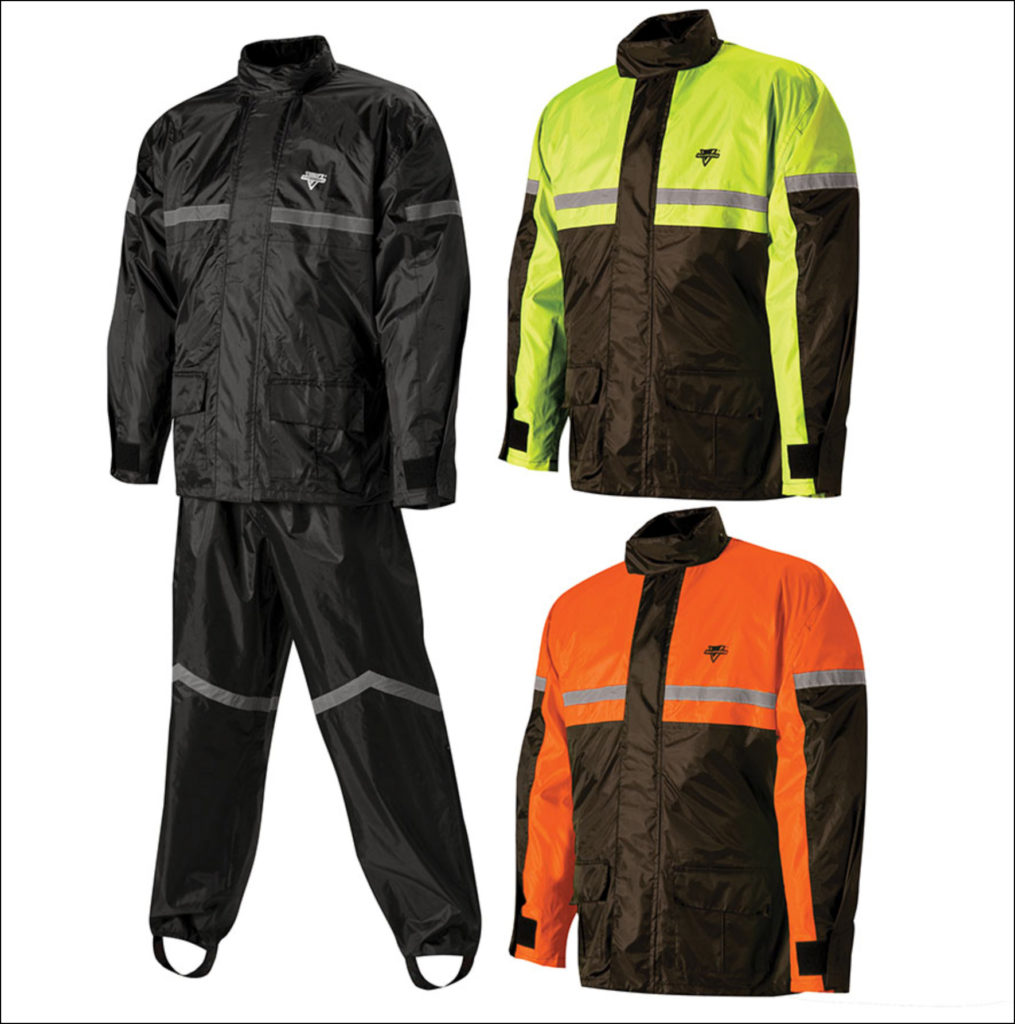
Nelson Rigg Stormrider® suit available in black and two high visibility colors
Easy to Use. Use it!
Proper rain gear is not expensive and will occupy a minimum amount of space on your bike. Personally I use a Nelson Rigg Stormrider® 2 piece rain suit. I purchased it one size larger than needed and it slips on easily over whatever normal riding gear I happen to be wearing. I can put it on and take it off quickly on the side of the road without even removing my boots.
Put it on are the operative words in that last sentence. I wish I had a dollar for every mile I’ve ridden in the rain; miserable and soaked to the bone. How many times I convinced myself that I wouldn’t get wet. Or that the rain would end and I’d dry out. Learn from my experience. If it looks like it could rain, put on your gear. Sounds pretty simple, doesn’t it? I hope you take my advice. You can thank me later.
Know When To Say No
The seasoned veterans out there will agree with me on this point. The real key to riding confidently in inclement weather comes down to one word. Experience. Like every other skill set you must practice it to become proficient. You’ll know you’ve pretty much arrived. It’s when you casually accept wet weather as just part of the game and, perhaps, even enjoy the experience.
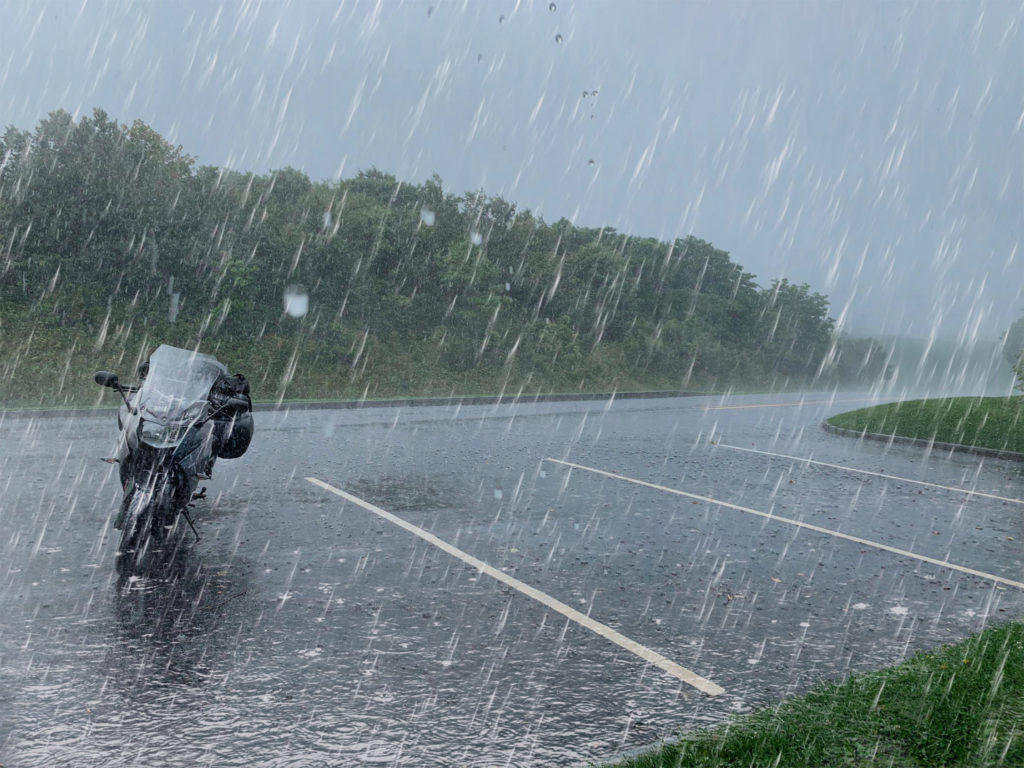
There are some storms that demand you “shut it down” and sit it out
Don’t let your confidence put you in harm’s way. Discretion truly is the better part of valor. There’s nothing heroic about riding on in life-threatening conditions. Heavy rain coupled with high winds can be an extremely dangerous combination. Make sensible choices. Deep ponding on roadways can drag an automobile sideways. It will down a motorcycle in the blink of an eye.
Make adjustments for decreased visibility…yours. Additionally that of the other vehicles you’re sharing the road with. Ride on carefully. Your beautiful machine will get dirty. Don’t sweat it. The water spots rinse off easily with fresh water. I don’t know about you. I’d rather stare out through a rain-spotted visor than stare at the four walls sitting at home.
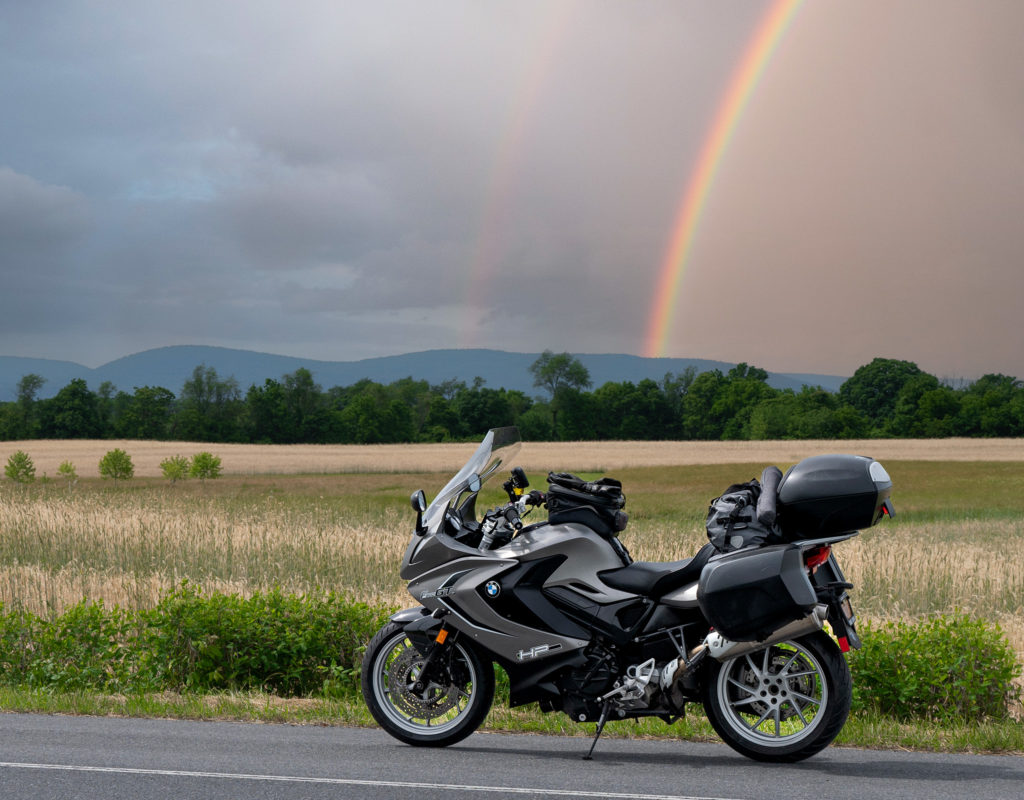
Always a welcome sight when you leave the wet weather behind you
Conclusion
We hope you have enjoyed this feature. In addition we hope that it inspires some of you on to more adventurous experiences. As always, we welcome your comments below. Feel free to share your experiences, stories and tips with our readers. Be sure to subscribe to Roadcraft USA for email notifications about future installments. Ride safe, everyone!
Click Here to view an interactive visual index page where you can quickly browse through all of the great features that are published on the Roadcraft USA blog.

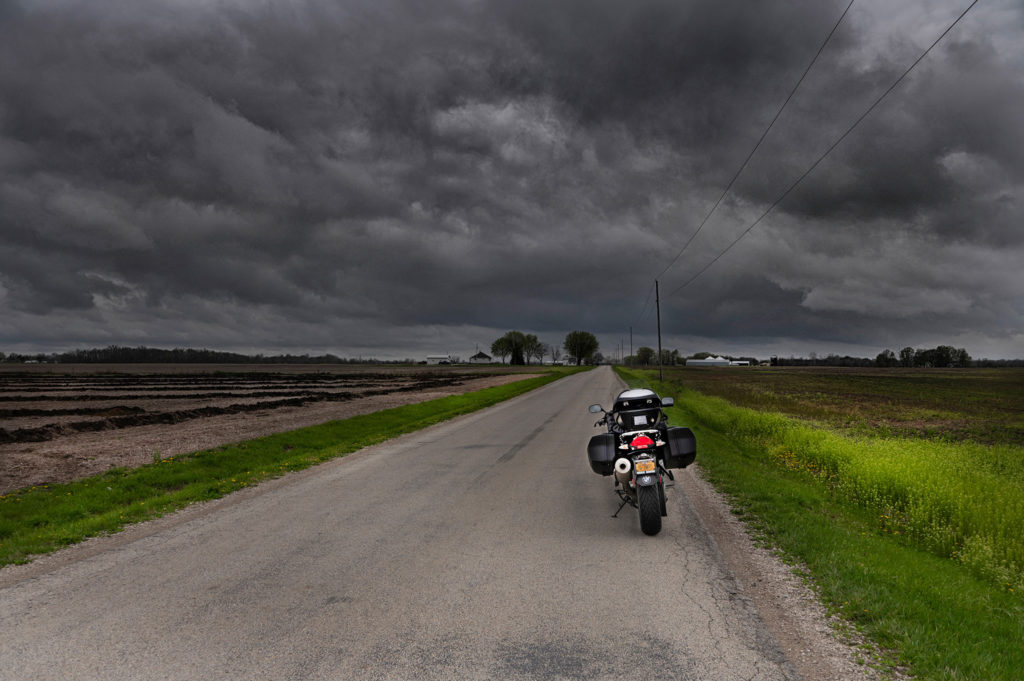

I have a lot of experience riding in the rain and I am very confident riding in the rain and know when it’s time to stop. I also ride Honda Goldwing with the last one having the rain driving mode which helps greatly. I have had 7 street motorcycles and the last 5 have been Goldwing. I will make a million miles by the end of the summer, probably at the Iron Butt Rally in Allen, Tx the middle of September. Excellent article and thanks very much and it’s always good to keep learning and taking advances riding classes every year.
Thanks for the compliment, Donald. I have no doubts that you have a lot of experience riding in the rain. You don’t get to one million miles without seeing adverse weather conditions. Yes…it’s always good to keep learning. I recently did the MSF advanced rider course again.
Pingback: outer banks lighthouses tour - Roadcraft USA
Pingback: amish travel vacation photography - Roadcraft USA
Pingback: sport touring motorcycle modifications - Roadcraft USA
Pingback: Nova Scotia motorcycle ride - Roadcraft USA
Pingback: motorcycle riding safety tips - Roadcraft USA